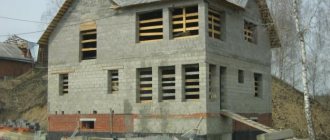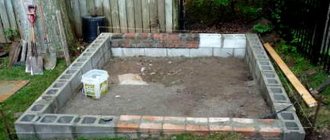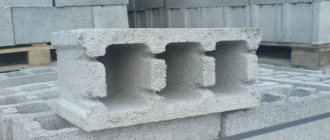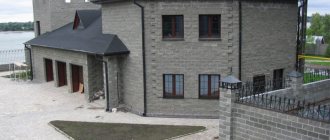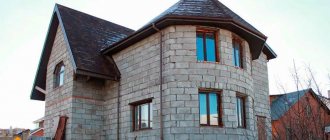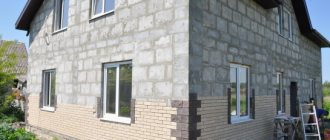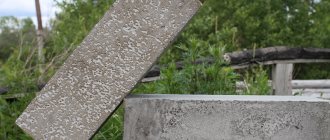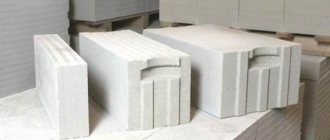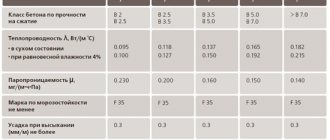- Differences and similarities of materials
Aerated concrete blocks are the most popular piece material for the construction of residential buildings. This is facilitated by the optimal price/quality ratio: for relatively little money the owner receives warm, strong, durable housing. Is there an alternative to aerated concrete? The main “competitor” of aerated block is, of course, cinder block. This is another popular material that has been used to build houses for almost a hundred years. What is better: aerated concrete or cinder block? Let's figure it out.
What is a cinder block made of?
Cinder block is called wall stone; to produce it, you need to properly prepare the mixture. Cinder block, the composition of the mixture is quite simple, is produced not only industrially, but also at home.
The standard solution includes components such as slag, ash or waste from metallurgical furnaces. It is not necessary to use such materials; you can use various fillers, limestone, expanded clay, sawdust, crushed stone, perlite or gravel. By maintaining the correct proportions and adding non-standard materials, you can increase strength and save on costs; such components may include broken bricks or other similar types of waste. Reinforced cinder block must comply with GOST.
It is necessary to comply with the main points
- The color according to the sample must be observed.
- According to GOST, the shape of the block must be strictly observed.
- The presence of voids or fullness.
- The thickness of the hollow partition and walls must be at least 20 millimeters.
The composition of the mixture must also comply with GOST conditions
- For production, cement 400 grade D 20 is used.
- Quartz sand must be cleaned and sifted.
- Screenings are raw materials that are obtained by crushing rock or crushed stone.
- Any water can be used, drinking or industrial.
The mixture for the production of cinder blocks includes sand, cement, slag, in proportions of 3 to 1 to 5. Water is added in the amount of half the volume of cement. If the blocks are made without the inclusion of sand, then the proportions change; for this, 1 part of cement and 9 slag is taken, the same amount of water is needed as in the first case. Complete hardening of the blocks, which will be ready for use, occurs after 30 days, at temperatures up to 20 degrees Celsius and high humidity. Hardening can be accelerated by adding a plasticizer to the mixture. After complete drying, the blocks are placed on prepared pallets, with the hollow areas facing down, this will help prevent cracks from appearing.
Varieties and their photographs
The retail chain offers a wide variety of cinder blocks, which are grouped according to characteristics, external dimensions, purpose and level of finishing.
Classification of cinder blocks by filling and finishing:
- Full-bodied, are used for structures capable of bearing increased loads: columns, plinth and foundation.
- Hollow with a void percentage of 28 to 40%, they are used for walls for various purposes. For load-bearing external walls, a lower void percentage is used.
- Septal cinder blocks have a thinner thickness from 90 to 120 mm.
- Decorative blocks with finishing coating on 1 or 2 sides. The finish can be varied, imitating natural stone or plaster. In addition to its beautiful appearance, it has increased heat and moisture protection.
- Colored blocks are used for the construction of pediments and other decorative elements. The color is obtained during the production process by adding crushed red brick or chalk of various colors.
- Fundamental The blocks are distinguished by high-strength characteristics that allow them to work for a long time, while they do not shrink or crumble.
More information about the types of cinder block is described in this article.
Type of filling material
The composition of the cinder block mixture varies according to the type of filling material, and is conventionally designated by various abbreviations.
- A mixture whose binding element is cement. (SCC)
- A solution where the binder is lime. (SKI)
- Addition of slag from various productions. (SKS)
- Using alabaster or plaster. (SKG)
The blocks are divided by size and marked in different ways, that is, number 1 means longitudinal view, 2 means half cinder block, 3 means partition wall type of material. When using a fastening component, it is better not to save money because blocks made with low grades of cement are not able to withstand significant loads and are weak to the effects of precipitation. Due to the influence of such factors, the edges of the block will peel off. Mixtures can be prepared in several ways.
Standard Features
Weight is determined by the size of the blocks, the density of the material and the manufacturer .
The material is produced by professional workshops, but there are also artisanal producers who also appear on the market, so there is some difference in size and parameters. The weight of a cinder block 20x20x40 will be almost half that of a stone with dimensions 40x40x20. Standard weight according to regulatory requirements:
- solid cinder block weighs 25 - 28 kg;
- hollow – 18 – 23 kg;
- half blocks – 10 – 13 kg.
of products to transmit heat depends on the type of filler . The thermal conductivity coefficient of the material with shell rock is 0.27 W/m K, and for coarse crushed stone products it increases significantly.
Other characteristics:
- the density of the material is in the range of 0.75 – 1.45 t/m3, the indicator affects the strength, which is in the range of 35 – 150 kg/cm2;
- Frost resistance is measured in 12 – 50 cycles, the area of use (northern, southern) depends on this.
The use of chemical production waste limits the scope of use of cinder blocks only to external structures. Blocks made independently can be made environmentally friendly by using slag and ash from burning wood and coal in household stoves and boilers for filling.
Methods for preparing mixtures for cinder block
The most common proportions are: part cement, 3 sand, 5 slag, the amount of water is equal to half the cement. Such proportions are used provided that the actual type of slag waste from metallurgical enterprises is used. To make the blocks high-quality and durable, the slag must be gray in color; it is used as a filling element.
You can use another type of mixture without using sand. To do this, you need to take one part of cement, and 9 slag from a metallurgical plant, the same amount of water is taken as in the first case.
If other materials are used, then the proportions change again; for this, take one part of cement, 4 screenings of the fine fraction, and water in the amount of half the volume of cement. In addition to the main components, a plasticizer can be added to any composition, although this is not mandatory. Using various additives, you can give the block the most ideal shapes, as well as speed up the process of their hardening.
After the mixture is completed, the prepared forms are filled with it; this work must be done immediately, since the solution sets quickly. Although the solution hardens quickly, the blocks need time to completely dry from the inside.
The main advantages of cinder block
The main advantage of this building material is its low cost. The composition of mixtures for making cinder blocks includes a large amount of slag, ash or other waste materials, which serve as the basis of the solution. This results in a low cost of blocks. In addition, cinder block has other positive characteristics.
- The material has high strength for the construction of walls up to three floors.
- The blocks are quite simple to lay; this work can be done independently, while saving on hiring workers.
- The components included in the composition are available.
- The construction of walls does not take much time, installation is quick.
Which GOST standards establish the requirements?
According to current legislation, it is not required that the cinder block exactly meet the requirements of GOST. However, many manufacturers issue a certificate of conformity for their products , since such cinder blocks are in greater demand among buyers. Manufacturers undergo this certification in a certification laboratory, which checks the compliance of products with established standards.
Current standards according to GOST regulating the production of cinder blocks:
| № | Document registration | The year of publishing | Name | Note |
| 1 | GOST 4.233 | 1986 | Masonry mortar | Requirements for indicators |
| 2 | GOST 6133 | 2019 | Concrete wall stones | Basic specifications |
| 3 | 31189 | 2003 | Dry mixes | Basic specifications |
| 4 | 31357 | 2007 | Dry mixes | Release Requirements |
| 5 | 31359 | 2007 | Autoclaved concrete | Basic specifications |
| 6 | 8462 | 1985 | Wall materials | Methods for establishing strength indicators |
| 7 | 57335 | 2016 | Concrete building blocks | Basic specifications |
| 8 | 6133 | 1999 | Concrete wall stones | Basic specifications |
How is cinder block made correctly?
You can make a mold for pouring the mixture yourself, observing the required dimensions. Cinder blocks are produced industrially or at home, that is, made in-house. To do this, it is necessary to use a vibrating machine, and the necessary raw materials for preparing the solution, and there must also be electrical power at the site.
- First, prepare a solution from cement, filler, water, and a plasticizer as desired. The proportions of cement may vary depending on its grades. As described above, it is better to use slag or other available materials as a filler. Mix the solution manually or using a concrete mixer to obtain a homogeneous mixture. If the work is done manually, you need to prepare a shovel or hoe, and a large container, for example, a trough or an old bathtub.
- The finished mixture is placed in molds and placed on a vibrating machine for compaction. Thanks to this procedure, the block will maintain its shape throughout the drying process. Compaction occurs in up to 30 seconds.
- Then the blocks are placed outdoors; it is advisable to place them on pallets so that in case of rain, they can be covered with polyethylene, thus protecting them from moisture. Cinder blocks are dried for about 4 weeks at a temperature of 20 degrees Celsius, air humidity should be high. To speed up drying, a plasticizer is added.
- After 96 hours, the blocks can be placed on special stands with the hollow side down, this will prevent their destruction, especially in winter.
The technology for producing blocks is not complicated; it allows you to do all the work at home.
The mixture for making cinder blocks consists of cement, which is considered a binding material, slag, which serves as a filler, water, and sand; it is not necessary to add this material. If desired, a plasticizer can be used; it promotes rapid hardening, which allows increasing the production of blocks. The slag must be of metallurgical production, usually it is gray in color, cement is 400 grade, sand is quartz, sifted, and purified, and any water can be used. All components must be thoroughly mixed until a homogeneous composition is formed; this is the only way to increase the strength of the blocks. Cinder blocks are used for the construction of walls, foundations, fences, and other building structures.
Where can cinder block be used?
The areas of use of cinder blocks are extensive: from foundations to various wall structures.
A cinder block foundation is installed in areas with dry, stationary soils, for objects that do not bear a large load. An important condition is the location of groundwater below the soil freezing line.
Laying walls is the most preferable option for using cinder blocks, since each such stone replaces 5-6 traditional bricks. For external walls, it is recommended to use hollow blocks with a hollowness of up to 30% , into the holes of which sawdust or other heat-insulating material is poured, thereby increasing the thermal protection of the house. In addition, to strengthen the wall structure, every 3rd row is reinforced with reinforced mesh.
